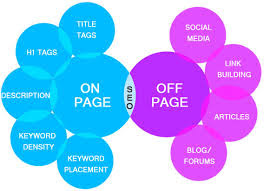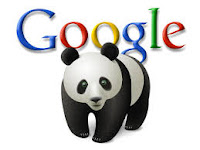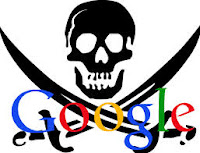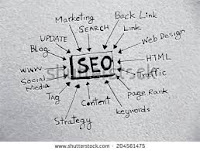INTRODUCTION TO ON-PAGE OPTIMIZATION
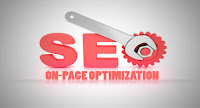 On-page optimization refers to modification with in the website in order to improve its position in search ranking, such as page title, meta tag, descriptions and internal linking etc..There are different steps to obtain On page optimizaion.
On-page optimization refers to modification with in the website in order to improve its position in search ranking, such as page title, meta tag, descriptions and internal linking etc..There are different steps to obtain On page optimizaion.On-Page Search Engine Optimization
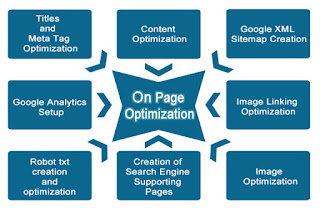 1. Title Page
1. Title Page
Title page is the most important SEO factor in a website. Each of a page and post should have its on
unique title and its include main keyword for that page.Keyword in page title can HELP your pages higher rank in google search result.Google is used the page title as title of a search snippet link in search engine results pages.
An effective page title created with how people search for things on the page in mind.
Meta Tag
HTML meta tags are formally page data tags that lie between the open and closing head tags in the HTML code of a document.
For each of the page can include a set of keywords in the form of Meta Tags.These keywords are relevant of the content.
There are four major meta tages;
- Meta Keywords Attribute : A series of keywords allow relevant to the page in question.
- Title Tag : This is the text at the top of the browser. Search engines view this text as the "title" of that page.
- Meta Description Attribute : A brief description of a page.
- Meta Robots Attribute : An explanation to search engine crawlers (robots or "bots") as to what they should do with the page.
2. Content Optimization
Content optimization gives the vision to create relevant, attractive
content that will help to increase the SEO rankings, drive more online
traffic and boost conversions. There are several parts of website that we will analyse and improve as part of this process.It include the content or copy, broken links, title tags and meta tags etc.Once these improvements are implemented, search engines will find it
easier to index your website and display it in relevant search results.
3. Google XML Sitemap Creation
 Sitemap communicate with google where it should go,so it can crawl the sites more quickly and get more of the content in to the search result.
Sitemap communicate with google where it should go,so it can crawl the sites more quickly and get more of the content in to the search result.
Sitemap is great for SEO.And it often great for users.There are two types of sitemap HTML & XML.
HTML
An HTML sitemap is really just a list of links.If a site doesn’t have large number of rich media like videos,images etc.And have relatively simple structure and doesn’t have lots of categories,this would be the way to go.
If want to create an HTML one,this sitemap generator creates HTML sitemap automatically and quickly,using the URL address.
XML
An XML sitemap isn’t visible to users,but it better for a large website.Because if create a sitemap within this sitemap there are number of free and paid tools are available.
The purpose of XML sitemap is to help google to find a key content more easily.
Here no coding experience is necessary.XML creation steps are:
- Simply enter your website URL.Make veriety of custom parameters in the form.
- Press ‘Generate sitemap’ button and wait until the site is completely crawled.
- You will be redirected to the generated sitemap details page.It includes number of pages,link list,XML file content and link to a sitemap file.
- Download the sitemap file using that link and put in to the domain root folder of your site.
- Go to your webmaster account and add your sitemap URL
- Click create sitemap.
4. Image Linking Optimization
Image are eye-catching,so are perfect for linking.proper image linking technique have better result in SEO.The basic tip for image linking is to avoid directly linking your images.Always use relevant anchor texts when ever linking your images.
Must use title tag when ever linking your image.Title tag provide a tool tip when you hover your cursor over a link.User relevant keywords are SEO friendly,descriptions are help to rock your title tag.
Must use title tag when ever linking your image.Title tag provide a tool tip when you hover your cursor over a link.User relevant keywords are SEO friendly,descriptions are help to rock your title tag.
5. Image Optimization
In SEO its important to use suitable keyword helps to webpage rank on search engine.Rich keyword file names is totally failure for image optimization.Search engine not only crawl the text but also search for keywords in the image file name on the webpage.
Alt tag are a text alternative to image. The Alt attribute also increase the value of a wesite. Adding appropriate alt tags to the image on the website can help the site achieve better ranking in search results by associating keywords with images.
A larger file size image can take longer time to load a webpage.Don’t place the largest images in webpages and simply shrink the dimension via the source code.There are three common file type that are used to post images.there are : JPEG/.jpg ,GIF & PNG.
Build a site with a logical link structure. Every page should be reachable from at least one static text link.Then the site is easily accessible one.
Don't fill a page with lists of keywords, attempt to "cloak" pages, or put up "crawler only" pages. If a site contains pages, links, or text that you don't intend visitors to see, Google considers those links and pages deceptive and may ignore your site.Don't use images to display important names, content, or links. Our crawler doesn't recognize text contained in graphics. Use ALT attributes if the main content and keywords on your page can't be formatted in regular HTML.So these are avoid to create a search engine supporting pages.
6. Creation of Search Engine Supporting Pages
Provide high-quality content on the pages, especially your homepage.This is the important thing and If a pages contain useful information, their content will attract many visitors and attract webmasters to link to a site.Links help as crawlers find a site and can give a site greater visibility in our search results.When returning results for a search, Google uses practical text-matching techniques to display pages that are both important and relevant to each search.Build a site with a logical link structure. Every page should be reachable from at least one static text link.Then the site is easily accessible one.
Don't fill a page with lists of keywords, attempt to "cloak" pages, or put up "crawler only" pages. If a site contains pages, links, or text that you don't intend visitors to see, Google considers those links and pages deceptive and may ignore your site.Don't use images to display important names, content, or links. Our crawler doesn't recognize text contained in graphics. Use ALT attributes if the main content and keywords on your page can't be formatted in regular HTML.So these are avoid to create a search engine supporting pages.
7. Robot txt Creation and Optimization
Robot.txt is great when search engines frequently visit a site and index a content but often there are cases when indexing parts of a online content is not what you want.Robots.txt is a text (not html) file you put on a site to tell search robots which pages you would like them not to visit. Robots.txt is by no means mandatory for search engines but generally search engines obey what they are asked not to do. It is important to clarify that robots.txt is not a way from preventing search engines from crawling your site.The location of robots.txt is very important. It must be in the main directory because otherwise user agents will not be able to find it they do not search the whole site for a file named robots.txt. Instead, they look first in the main directory.Absence of a robots.txt file will not stop search engines from crawling and indexing a website.8. Google Analytics Setup
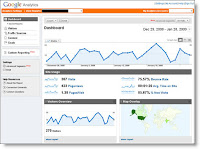 To setup Google analytic tracking,usually need either analytic tracking ID or the entire java script tracking code snippet.This is similar to the analytic property.To find the tracking ID and code snippet,sign in to your analytic account.
To setup Google analytic tracking,usually need either analytic tracking ID or the entire java script tracking code snippet.This is similar to the analytic property.To find the tracking ID and code snippet,sign in to your analytic account.The google analytic setup steps are :
- Create social media objectives and goal for your website.
- Sign up for google analytics.
- Setup your google analytics tracking code.
- Google tag manager
- Adding the tracking code directly to your site.
To set up the web tracking code :
- Sign in to your google analytic account.select the admin tab.from the account,property and view that you want to track.
- Copy the snippet.Make sure that not reuse the same tracking code snippet on multiple domain.
- Paste your snippet into every webpage and before the closing tag.
- Check whether the google analytic is same that your website source code.
4. Setup google analytic goals
5. Understanding social analytic reports.
6. Reporting data from these reports.
5. Understanding social analytic reports.
6. Reporting data from these reports.
CONCLUSION
The content described this Article are some of the On page optimization techniques for improving your website or webpage ranking. Many other techniques are also available for optimization.
